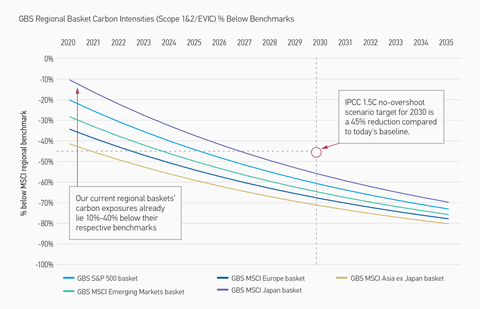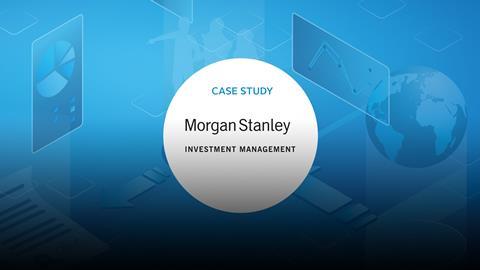Case study by Morgan Stanley Investment Management
- Signatory type: Investment manager
- Region of operation: Global
- Asset under management: US$665bn (30/06/20)
To maximise returns over time while actively managing total portfolio risk, our Global Balanced Risk Control (GBaR) strategy invests in a broad, balanced asset mix. In our MS INVF Global Balanced Sustainable (GBS) Fund, sustainable investing is a natural extension of our focus on risk control, as we strongly believe that incorporating ESG considerations in our investment decisions can enhance long-term risk-adjusted returns.
Why incorporate ESG considerations into SAA in a multi-asset portfolio?
We use a range of sustainable investing strategies in our asset allocation process, for a range of different purposes.

Restriction screening
We apply norms-, values- and fossil fuel-based exclusion criteria to the investment universe to avoid investments that are proven, or have the potential, to cause significant harm to the environment and/or society, while maintaining the integrity of our portfolio construction process.
Integration
We integrate company ESG ratings and a low-carbon transition assessment to build tilted regional equity baskets.
Impact
Our portfolio has a permanent allocation to impact investments in both equity and fixed income to generate a positive environmental or social impact alongside financial returns. They are subject to a rigorous internal materiality and purity assessment.
Engagement
We conduct thematic engagements to understand how companies are positioned to mitigate risks and leverage opportunities on material ESG issues such as climate change and human capital, which in turn inform our investment decision making and proxy voting process.
In order to further safeguard investment from the increasing risks posed specifically by climate change, we have further enhanced our ESG integration process with an additional climate alignment overlay. Recognising the need for climate-ambitious investment vehicles, we have designed a 1.5oC-compatible decarbonisation trajectory for our direct equity exposure, subject to time-bound, science-based targets. We are currently working on similar climate overlay considerations for our fixed income exposure – along with a similar restriction screening and integration process.
How we include climate considerations specifically into our ESG-related SAA
Within the ESG integration process we have two distinct climate overlays: stock-specific and sector-specific. For the stock-specific, we create – for all 11 GICS sectors within each regional equity market – individual baskets that tilt towards the top quartile ESG and low-carbon transition leaders, in aggregate. For the sector-specific, we aggregate the sector baskets subject to an overall carbon budget, aligned with a science-based climate trajectory.
Stock-specific
To identify leaders and laggards on climate transition, along with company ESG ratings we use a low-carbon transition indicator. This helps us to distinguish companies that are at high risk of having stranded assets in a low-carbon future from those that are solutions providers, offering low-carbon opportunities. It also allows us to differentiate between companies within sectors, based on factors such as how well they manage low-carbon risks. Armed with that data we can target the top quartile of securities, thus naturally decarbonising our sector stock baskets and shifting our holdings into more 1.5oC-aligned companies on average.
Sector-specific
In order to reduce the carbon exposure of our direct equity holdings further, we introduced an additional overlay for the Global Balanced Sustainable fund, whereby we allow the sector weights to deviate from the underlying equity index (such as S&P 500 or MSCI Europe), at the regional aggregation stage. This results in the regional equity baskets’ carbon emissions decreasing in line with a science-based approach aimed at decarbonising the portfolio according to a 1.5oC scenario, aligned with the most recent IPCC recommendations and targeting net zero for our equity exposure by 2050.
So far our stock-specific tilts alone have decarbonised regional equity baskets by 10%-40% compared to their respective underlying equity index benchmarks as of mid-2020 (Chart 1). This gives us a strong starting position from which to decarbonise positions further over the following years, while already putting us ahead of key scientific milestone targets when using the additional sector-level overlay.
Chart 1: Global Balanced Sustainable (GBS) carbon intensity trajectory compared to IPCC key milestone target for 2030

As our strategy is based upon a broad investment universe and our ESG overlay is designed to complement the existing top-down asset allocation process, we chose a benchmark-based approach – establishing a 1.5oC-aligned and science-based decarbonisation trajectory for a portfolio-relevant benchmark (rather than selecting individual companies based on forward-looking publicly disclosed decarbonisation targets, or setting decarbonisation targets per industrial sector). We back this up with an optimisation process allowing us to transition the portfolio over time.
For the optimisation, we align with commonly advocated metrics (e.g. those advocated by the EU Climate Benchmark), such as Scope 1 and 2 emissions over enterprise value including cash (EVIC), to arrive at the carbon intensity of our baseline regional equity baskets. We then reduce carbon emissions gradually and in line with scientific milestones by varying sector weights within each regional equity basket, subject to the aforementioned carbon constraint and minimising tracking error. To stay as close to sector neutrality as possible and not penalise individual sectors disproportionately, we constrain absolute sector weight deviations to +/- 5%.
This approach has several advantages:
- We can tailor our optimisation to changing milestone targets as scientific progress is made (and/or as scientific targets adjust to new environmental realities).
- We ensure that we see absolute emission reductions in our portfolio, by adjusting emissions over EVIC intensity targets between quarterly rebalances for increases in EVIC (which would otherwise cause a relative decrease in emissions and not an absolute one).
- We can incorporate existing and future decarbonisation gains, stemming from other parts of our climate methodology.
- We can always stay below the carbon profiles of the respective regional benchmarks and ensure that we consistently meet our decarbonisation milestones relative to their baselines, at the point of rebalance (i.e, we do not rely on company forecasts, but only on actual, realised data).
- The tracking error minimisation objectives allow us to meet climate goals without compromising on returns.












